Developer Guide
Table of Contents
- Table of Contents
- Introduction
- Legend for Boxes
- Acknowledgements
- Setting up, getting started
- Design
- Legend for Diagrams
- Implementation
- Documentation, logging, testing, configuration, dev-ops
- Appendix: Requirements
- Appendix: Instructions for manual testing
Introduction
What is LinkedOUT?
LinkedOUT is the only application that any experienced recruiter needs. LinkedOUT allows recruiters to keep track of many applicants, and the job they applied for. You can store their contact details, skills and the round of their application, all in one place.
LinkedOUT helps recruiters manage the multiple job applications they may receive on a daily basis. With many applications, it may be difficult to keep track of each applicant and which application round they are currently at.
Thus, LinkedOUT aims to improve a recruiter’s experience. LinkedOUT presents recruiters with the ability to flag important applicants, edit applicants easily and search for them with ease.
LinkedOUT comes with a Command Line Interface CLI as well as a Graphical User Interface GUI in order to provide recruiters a more streamlined experience.
Who is this Developer Guide for?
This developer guide is meant for those who wish to understand the architecture and design considerations of LinkedOUT.
Certain technical terms are specified in italics. If you need to reference what they mean, you can do so by referring to our Glossary.
If you would like to learn more about the target group and how the application addresses their concerns, skip ahead to the Requirements.
If you would like to learn how to use the application instead, you can do so by reading our User Guide.
Legend for Boxes
![]() Notes:
Notes are placed in this guide to specify extra details and elaboration.
Notes:
Notes are placed in this guide to specify extra details and elaboration.
Acknowledgements
This project is based on the AddressBook-Level3 project created by the SE-EDU initiative.
Libraries used: JavaFX, Jackson, JUnit5.
Setting up, getting started
Refer to the guide Setting up and getting started.
Design
![]() Notes: The
Notes: The .puml files used to create diagrams in this document can be found in the diagrams folder. Refer to the PlantUML Tutorial at se-edu/guides to learn how to create and edit diagrams.
Legend for Diagrams
The following colour schemes are used in the diagrams. They each refer to a specific component. The colour used in the diagrams may vary in shade, but still belong to one of the component categories as listed below:
-
Represents UI Component -
Represents Logic Component -
Represents Model Component -
Represents Storage Component -
Represents Main Component
Architecture
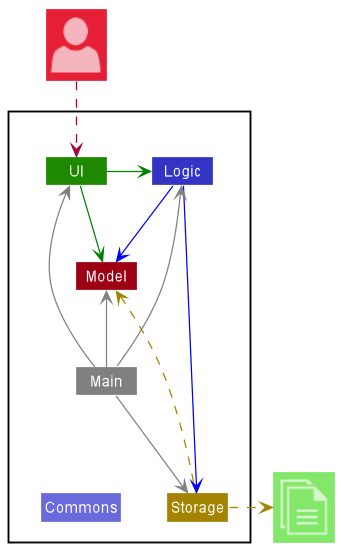
The Architecture Diagram given above explains the high-level design of the App.
Given below is a quick overview of main components and how they interact with each other.
Main components of the architecture
Main has two classes called Main and MainApp. It is responsible for,
- At app launch: Initializes the components in the correct sequence, and connects them up with each other.
- At shut down: Shuts down the components and invokes cleanup methods where necessary.
Commons represents a collection of classes used by multiple other components.
The rest of the App consists of four components.
-
UI: The UI of the App. -
Logic: The command executor. -
Model: Holds the data of the App in memory. -
Storage: Reads data from, and writes data to, the hard disk.
How the architecture components interact with each other
The Sequence Diagram below shows how the components interact with each other for the scenario where the user issues the command delete 1.
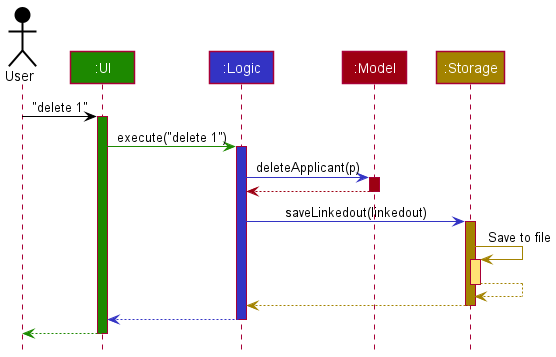
Each of the four main components (also shown in the diagram above),
- defines its API in an
interfacewith the same name as the Component. - implements its functionality using a concrete
{Component Name}Managerclass (which follows the corresponding APIinterfacementioned in the previous point.
For example, the Logic component defines its API in the Logic.java interface and implements its functionality using the LogicManager.java class which follows the Logic interface. Other components interact with a given component through its interface rather than the concrete class (reason: to prevent outside component’s being coupled to the implementation of a component), as illustrated in the (partial) class diagram below.
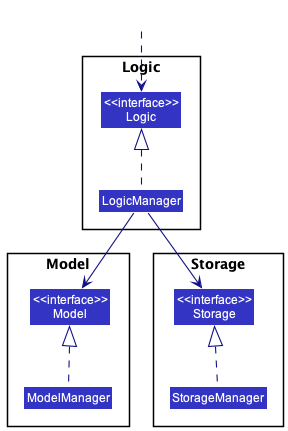
The sections below give more details of each component.
UI component
The API of this component is specified in Ui.java
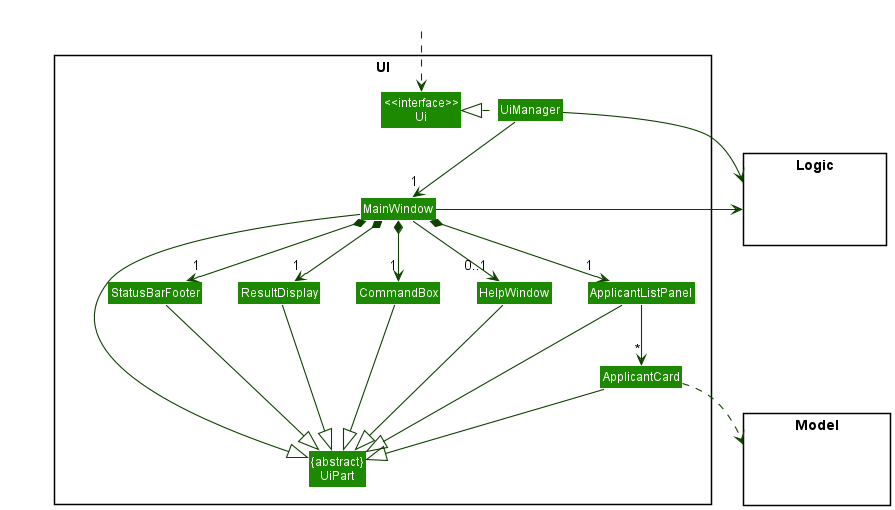
The UI consists of a MainWindow that is made up of parts e.g.CommandBox, ResultDisplay, ApplicantListPanel, StatusBarFooter etc. All these, including the MainWindow, inherit from the abstract UiPart class which captures the commonalities between classes that represent parts of the visible GUI.
The UI component uses the JavaFx UI framework. The layout of these UI parts are defined in matching .fxml files that are in the src/main/resources/view folder. For example, the layout of the MainWindow is specified in MainWindow.fxml
The UI component,
- executes user commands using the
Logiccomponent. - listens for changes to
Modeldata so that the UI can be updated with the modified data. - keeps a reference to the
Logiccomponent, because theUIrelies on theLogicto execute commands. - depends on some classes in the
Modelcomponent, as it displaysApplicantobject residing in theModel.
Logic component
API : Logic.java
Here’s a (partial) class diagram of the Logic component:

How the Logic component works:
- When
Logicis called upon to execute a command, it uses theLinkedoutParserclass to parse the user command. - This results in a
Commandobject (more precisely, an object of one of its subclasses e.g.,AddCommand) which is executed by theLogicManager. - The command can communicate with the
Modelwhen it is executed (e.g. to add an applicant). - The result of the command execution is encapsulated as a
CommandResultobject which is returned back fromLogic.
The Sequence Diagram below illustrates the interactions within the Logic component for the execute("delete 1") API call.

DeleteCommandParser should end at the destroy marker (X) but due to a limitation of PlantUML, the lifeline reaches the end of diagram.
This limitation extends to the rest of our diagrams which are of the same type.
Here are the other classes in Logic (omitted from the class diagram above) that are used for parsing a user command:

How the parsing works:
- When called upon to parse a user command, the
LinkedoutParserclass creates anXYZCommandParser(XYZis a placeholder for the specific command name e.g.,AddCommandParser) which uses the other classes shown above to parse the user command and create aXYZCommandobject (e.g.,AddCommand) which theLinkedoutParserreturns back as aCommandobject. - All
XYZCommandParserclasses (e.g.,AddCommandParser,DeleteCommandParser, …) inherit from theParserinterface so that they can be treated similarly where possible e.g, during testing.
Model component
API : Model.java
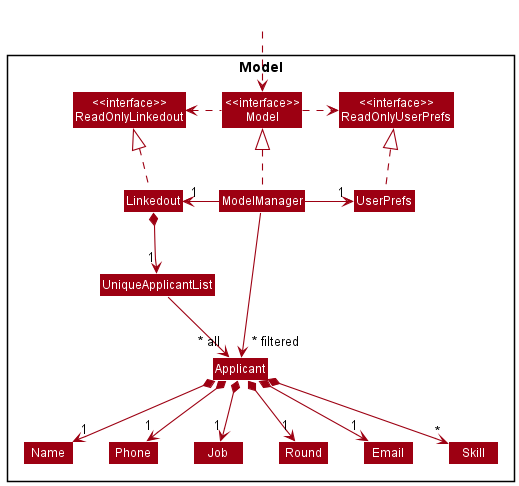
The Model component,
- stores the LinkedOUT application data i.e., all
Applicantobjects (which are contained in aUniqueApplicantListobject). - stores the currently ‘selected’
Applicantobjects (e.g., results of a search query) as a separate filtered list which is exposed to outsiders as an unmodifiableObservableList<Applicant>. This filtered list is then wrapped around aSortedListto create a filtered, sorted list that can be ‘observed’ e.g. the UI can be bound to this list so that the UI automatically updates when the data in the list changes or is sorted. - stores a
UserPrefobject that represents the user’s preferences. This is exposed to the outside as aReadOnlyUserPrefobjects. - does not depend on any of the other three components (as the
Modelrepresents data entities of the domain, they should make sense on their own without depending on other components)
Storage component
API : Storage.java
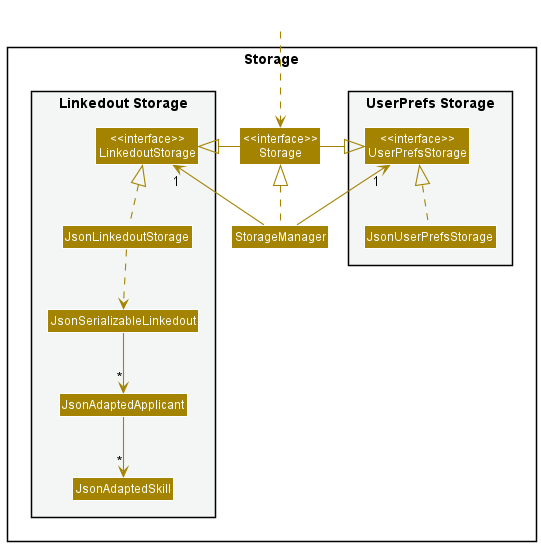
The Storage component,
- can save both LinkedOUT application data and user preference data in json format, and read them back into corresponding objects.
- inherits from both
LinkedoutStorageandUserPrefStorage, which means it can be treated as either one (if only the functionality of only one is needed). - depends on some classes in the
Modelcomponent (because theStoragecomponent’s job is to save/retrieve objects that belong to theModel)
Common classes
Classes used by multiple components are in the seedu.linkedout.commons package.
Implementation
This section describes some noteworthy details on how certain features are implemented.
Add applicant feature
Rationale
The add command allows the user to add a new applicant to the LinkedOUT list.
Implementation
The add command is facilitated by creating an AddCommand. AddCommand extends Command and implements the Command#execute() method.
The following activity diagram shows the workflow for the add operation:
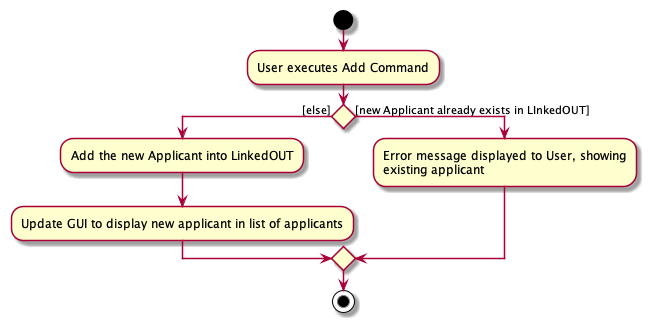
Given below is an example usage scenario of how an applicant is added, and how the operation is handled by LinkedOUT:
-
The user enters a valid add command, for example:
add n/Bob p/99991111 e/bob@mail.com j/Data Analyst r/Interview s/Python. For each commandLogicManager#execute()is invoked, which callsLinkedoutParser#parseCommand()to separate the command wordaddand the argumentn/Bob p/99991111 e/bob@mail.com j/Data Analyst r/Interview s/Python -
Upon identifying the add command,
AddCommandParseris instantiated and usesAddCommandParser#parse()to map the various prefixes to the attributes: (e.gn/toBob,p/to99991111) -
AddCommandParser#arePrefixesPresent()is called to ensure all the mandatory prefixes have been inputted by the user. After whichAddCommandParser#parse()creates the newApplicant -
AddCommandParser#parse()then initializes anAddCommandwith the newApplicantas an argument.AddCommand#execute()is then called, which callsModel#hasApplicant()to ensure that the newApplicantis not a duplicate of any existing applicant in the LinkedOUT. upon completion of the check,Model#addApplicant()to add the new applicant in LinkedOUT. -
The command is complete and a
CommandResultcontaining the details of the new applicant as a String is returned to the user.
The following sequence diagram shows how the add operation works:

Design considerations
Aspect: How add executes:
-
Alternative 1 : Check whether specified applicant already exists before creating an Applicant object.
- Pros: Avoid creation of unnecessary objects
- Cons: May cause reduced performance
Add Skill feature
Rationale
The addskill command allows users to add skills to a specific applicant. This command was designed to accommodate edit’s functionality when editing skills. To remove skills from an applicant, one can choose to use edit instead.
The reasoning for only including an addskill functionality is that most applicants would pick up new skills, but not lose knowledge of pre-existing ones.
Implementation
The addskill mechanism is facililated by AddSkillCommandParser.
AddSkillCommandParser parses the inputs using AddSkillCommandParser#parseSkillsForEdit() and returns a new set of skills to AddSkillCommand.
AddSkillCommand then searches for the applicant within the applicant list, and appends the skills to the pre-existing set.
As the skills being passed are checked in AddSkillCommandParser and Skill upon instantiation, skills parsed can contain a mix of symbols and alphanumeric. They must also be made up of 1 to 5 words.
The following activity diagram shows the workflow for the addskill operation:

Given below is an example usage scenario of how an applicant is edited.
-
The user enters the addskill command with the specific index and skills to add,
addskill 1 s/C++ s/Vue. -
LinkedoutParseris invoked to handle the commandaddskillthroughLinkedoutParser#parseCommand(). -
It then calls upon
AddSkillCommandParser#parse()to check if the input is empty. -
If input is not empty, it passes the input to
AddSkillCommandParser#parseSkillsForEdit()to create a new set, representing the skills to be added. -
The result is then used to instantiate
AddSkillCommand.AddSkillCommandthen finds the applicant at the specified index. -
With
AddSkillCommand#createEditedApplicant(), the applicant’s pre-existing skills are appended with the new set, and the applicant is added to the model. -
It then calls upon
CommandResultto display the final result on the GUI.
The following sequence diagram shows how the addskill operation works:

Design considerations
Aspect: How addskill executes:
-
Alternative 1 (current choice): Creates a new applicant replace old information.
- Pros: Easy to implement.
- Cons: May have performance issues in terms of memory usage.
-
Alternative 2: Change edit command functionality to allow it to add, delete, clear and replace skills.
- Pros: One lesser command needed.
- Cons: Adds extra complexity in code as well as for the user.
Edit applicant feature
Rationale
The edit command allows users to change the applicant’s details.
Implementation
The proposed edit mechanism is facilitated by EditApplicantDescriptor. EditApplicantDescriptor stores the details of the applicant to change.
The user need to specify an Index to select the applicant to edit. editCommand extends Command and implements the Command#execute() method.
The following activity diagram shows the workflow for the edit operation:
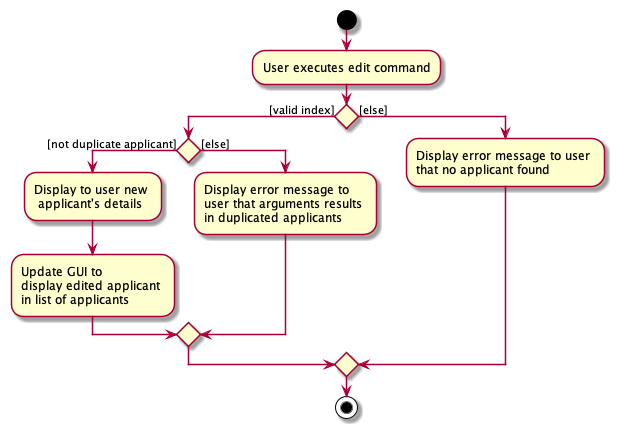
Given below is an example usage scenario of how an applicant is edited.
-
The user enters the edit command with the specific fields to edit,
edit 1 n/Alex Tan. -
LinkedoutParseris invoked to handle the commandeditthroughLinkedoutParser#parseCommand(). -
It then calls upon
EditCommandParser#parse()to map the various prefixes to the attributes: (e.gn/toAlex Tan). -
If input is not empty, it passes the input to
EditCommandParser#parse()to create aEditApplicantDescriptor, representing the applicant’s attributes after editing.EditApplicantDescriptoralso checks to make sure there are changes made. -
The result is then used to instantiate
EditCommand.EditCommandthen finds the applicant at the specified index. -
With
EditCommand#createEditedApplicant(), the edited applicant is created with the new information and the applicant is added to the model. -
It then calls upon
CommandResultto display the final result on the GUI.
The following sequence diagram shows how the edit operation works:

Design considerations
Aspect: How edit executes:
-
Alternative 1 (current choice): Creates a new applicant replace old information.
- Pros: Easy to implement.
- Cons: May have performance issues in terms of memory usage.
-
Alternative 2: Replace individual fields inside original applicant.
- Pros: Will use less memory (Do not have to create an extra applicant).
- Cons: We must ensure that the implementation of each individual command to change an information is correct.
View applicant feature
Rationale
The view command searches a single applicant in LinkedOUT and returns the applicant’s details. It is used when users wish to find a specific applicant they have in mind. It takes in a single case-insensitive parameter, which is the applicant’s full name. No prefix is required.
Implementation
The view command is facilitated by NameContainsAllKeywordsPredicate which helps the parser match the input.
The user needs to specify a Name to allow the application to match and select the applicant. ViewCommand extends Command and implements the Command#execute() method.
As ViewCommandParser uses NameContainsAllKeywordsPredicate, the Name being passed will not match if it contains additional whitespace, but will match inputs which are case-insensitive.
The following activity diagram shows the workflow for the view operation:
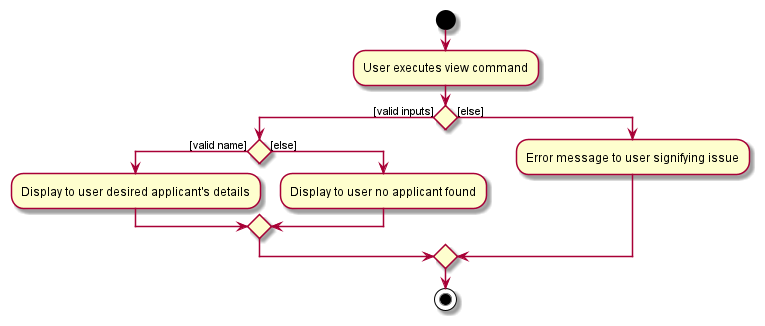
Given below is an example usage scenario of how to view a specific applicant.
-
The user enters the view command with the specific name,
view Alex Tan. -
LinkedoutParseris invoked to handle the commandviewthroughLinkedoutParser#parseCommand(). -
It then calls upon
ViewCommandParser#parse()to check if the input is empty. -
If input is not empty, it passes the input to
NameContainsAllKeywordsPredicate(). -
The result is then initialized as a predicate in
ViewCommand.ViewCommand#execute()then tries to find a match. -
It then calls upon
CommandResultto display the final result on the GUI.
The following sequence diagram shows how the view operation works:
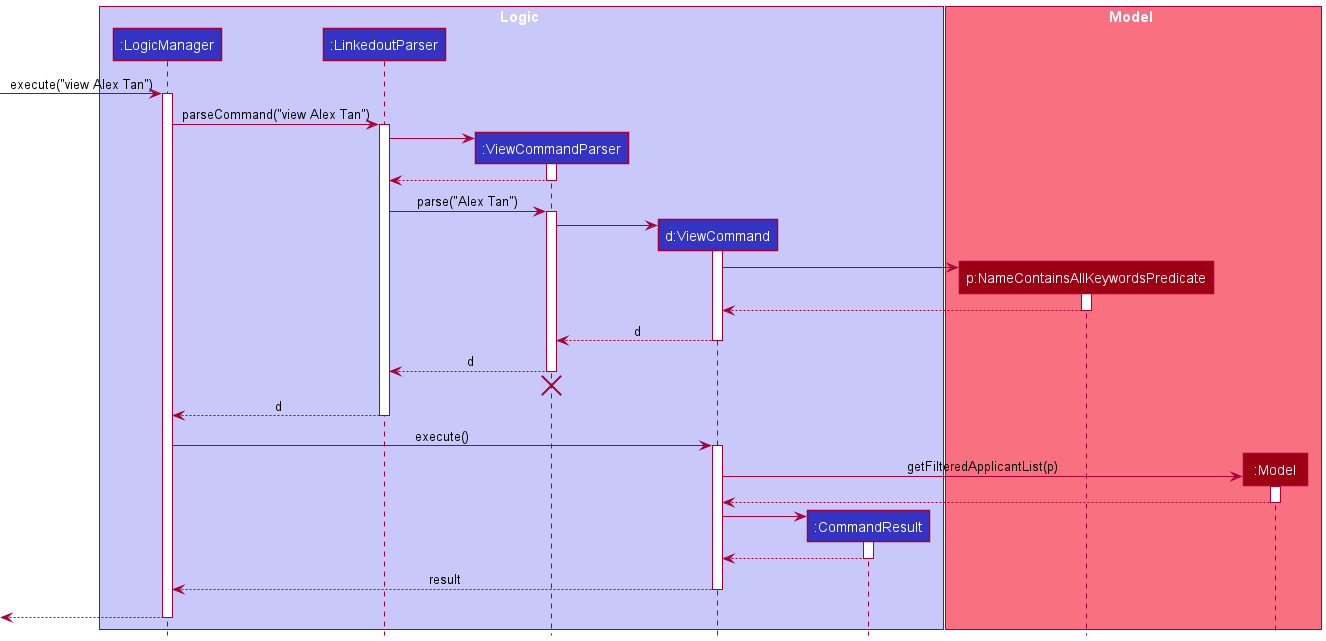
Design considerations
Aspect: How view executes:
-
Alternative 1 (current choice): Shows a single applicant.
- Pros: Easy to implement.
- Pros: Result is specific.
- Cons: Strict matching.
- Cons: Have to remember applicant’s name and type it fully.
-
Alternative 2: Shows multiple applicants based on partial matches.
- Pros: Less strict matching.
- Cons: Users are unable to single out a certain applicant.
Weighing the pros and cons of these alternatives, we have decided to abstract alternative 2 as a different feature under search.
This is to allow our target user to have greater flexibility, and we believe both are important features to be implemented.
Search applicant feature
Rationale
The search command searches for applicant(s) in LinkedOUT and returns the applicant(s)’ details. It is used when users wish to search for applicant(s) they have in mind. It takes in prefix(es) with case-insensitive parameter, which can be applicant’s name, job, round and skill.
Implementation
The proposed search mechanism is facilitated by SearchCommandParser. SearchCommandParser will map the creation of KeywordsPredicate based on the input prefix. KeywordsPredicate supports the following implementation:
-
NameContainsKeywordsPredicate— Predicate which returns true if an applicant’s full name matches partially with the exact input attribute. -
JobContainsKeywordsPredicate— Predicate which returns true if an applicant’s job name matches partially with the exact input attribute. -
RoundContainsKeywordsPredicate— Predicate which returns true if an applicant’s round matches partially with the exact input attribute. -
ApplicantContainsSkillKeywordsPredicate— Predicate which returns true if an applicant’s skill matches partially with the exact input attribute.
These predicates assist the filtering of applicant list in the Model interface, specifically for Model#updateSearchApplicantList() and Model#getDefaultApplicantList().
The following activity diagram shows the workflow of the search command:
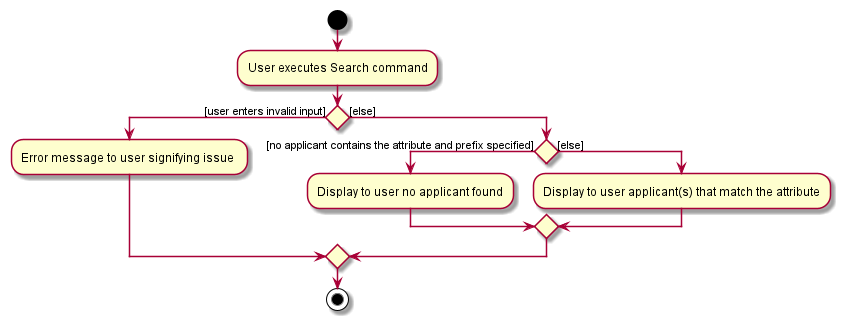
Given below is an example usage scenario and how the search mechanism behaves at each step.
Example 1
-
The user enters search command with prefix and specified attribute,
search n/David Lee. -
The input attributes will be passed into
SearchCommandParserand creates aNameContainsKeywordsPredicateif the attribute and prefix are not empty. -
The predicate is then passed into
Model#updateSearchApplicantList()to filter and display applicants with partial name matching ofDavidorLeein LinkedOUT.
Example 2
-
The user enters
search j/Software n/Davidcommand to search for applicants in LinkedOUT. -
The input attributes will be passed into
SearchCommandParserand creates aJobContainsKeywordsPredicateandNameContainsKeywordsPredicateif the attributes are not empty. -
The predicate is then passed into
Model#updateSearchApplicantList()to filter and sort the applicants with partial job and name matching ofSoftwareorDavid. Applicant with the most matched attributes will be displayed on the top of LinkedOUT.
The following sequence diagram shows how the search operation works:

Design considerations:
Aspect: How search executes:
-
Alternative 1 (current choice): Uses prefixes to search for applicants with combination of matching attributes.
- Pros: Able to search an applicant using combination of different fields/prefixes. Provides a more precise and broader search.
- Cons: Hard to implement.
-
Alternative 2: Only search for an applicant using partial matching name.
- Pros: Easy to implement.
- Cons: Inflexible use of search command.
Sort applicant feature
Rationale
The sort command shows the list of applicants temporarily sorted by either NAME or JOB and in ascending or descending order.
Implementation
The proposed sort mechanism is facilitated by SortCommandParser.
SortCommandParser will map the creation of SortComparator based on the input prefix and returns a SortCommand with
the SortComparator.
SortCommand extends Command and implements the Command#execute() method.
The following activity diagram shows the workflow of the search command:
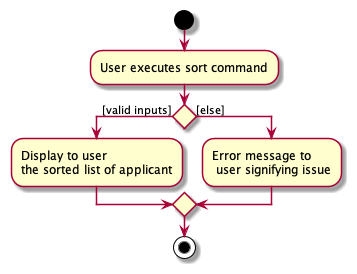
Given below is an example usage scenario and how the search mechanism behaves at each step.
-
The user enters the sort command with the specific field to sort by and sorting order,
sort f/name o/asc. -
The input fields will be passed into
SortCommandParserand creates aSortComparatorif the field and order are not empty. -
The
SortComparatoris then passed intoModel#updateDefaultApplicantList()to sort and display the list of sorted applicants in LinkedOUT.
The following sequence diagram shows how the sort operation works:
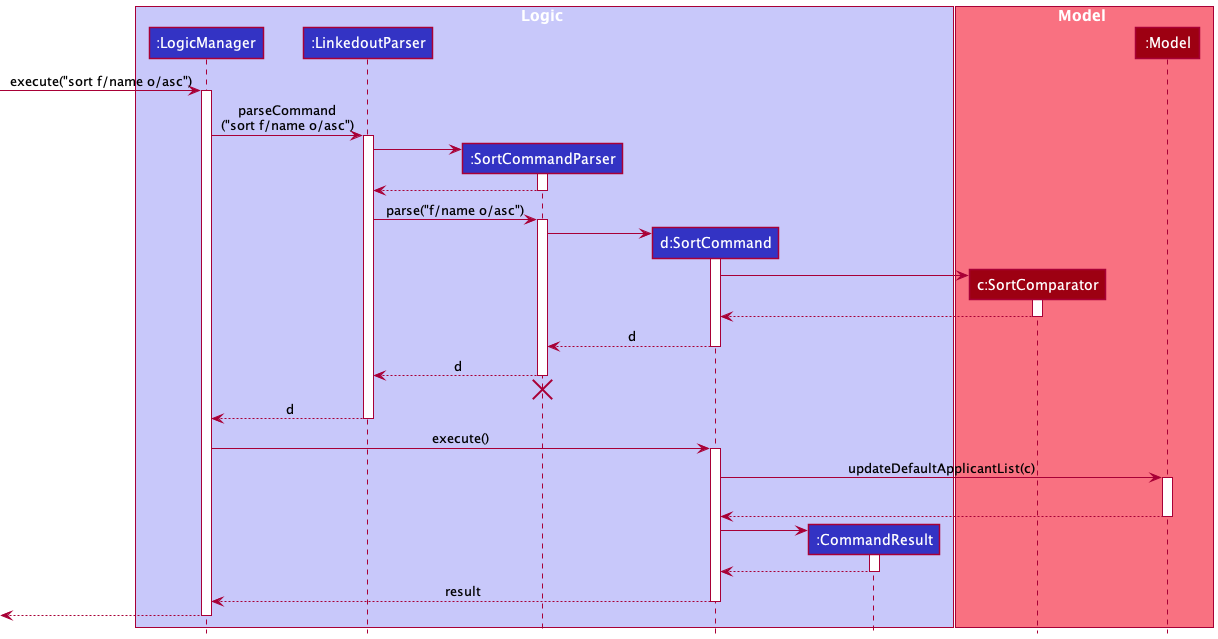
Design considerations:
Aspect: How sort executes:
-
Alternative 1 (current choice): Displays a temporary sorted list
- Pros: Original order of list retained.
- Cons: Unable to sort list permanently.
-
Alternative 2: Sort list permanently.
- Pros: List can be permanently sorted.
- Cons: Original order in list is lost.
Flag applicant feature
Rationale
The flag feature and it’s associated flag command allows the user to flag an existing applicant in the LinkedOUT list, pinning them to the top for easy reference.
Implementation
The flag mechanism is facilitated by the FlagCommandParser. FlagCommandParser parses the user inputs using FlagCommandParser#parse() to obtain the index of the applicant to be flagged.
FlagCommand then searches for the applicant in the applicant list, and toggles it’s flagged status.
The following activity diagram shows the workflow for the flag operation:
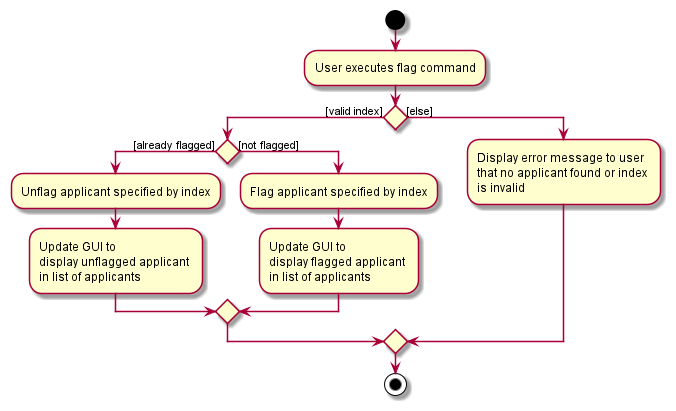
Given below is an example usage scenario of how an applicant is flagged, and how the operation is handled by LinkedOUT:
-
The user enters a valid flag command, for example:
flag 1. For each commandLogicManager#execute()is invoked, which callsLinkedoutParser#parseCommand()to separate the command wordflagand the argument1. -
Upon identifying the flag command,
FlagCommandParseris instantiated and usesFlagCommandParser#parse()to obtain the index of the applicant to be flagged. -
ParserUtil#parseIndex(args)is then called byFlagCommandParser#parse()to obtain the index of the applicant to be flagged as an argument to be passed around internal components, as well as to check the validity of the index provided. -
FlagCommandParser#parse()then initializes aFlagCommandwith the obtained index as the argument. -
The logic manager calls
FlagCommand#execute()which obtains the applicant at the specified index. -
With
FlagCommand#createFlaggedApplicant(), the applicant obtained is cloned, but it’s flagged status is toggled, and the initial applicant obtained is replaced by its cloned version. -
A call to
CommandResultthen displays the final result on the GUI.
The following sequence diagram shows how the flag operation works:
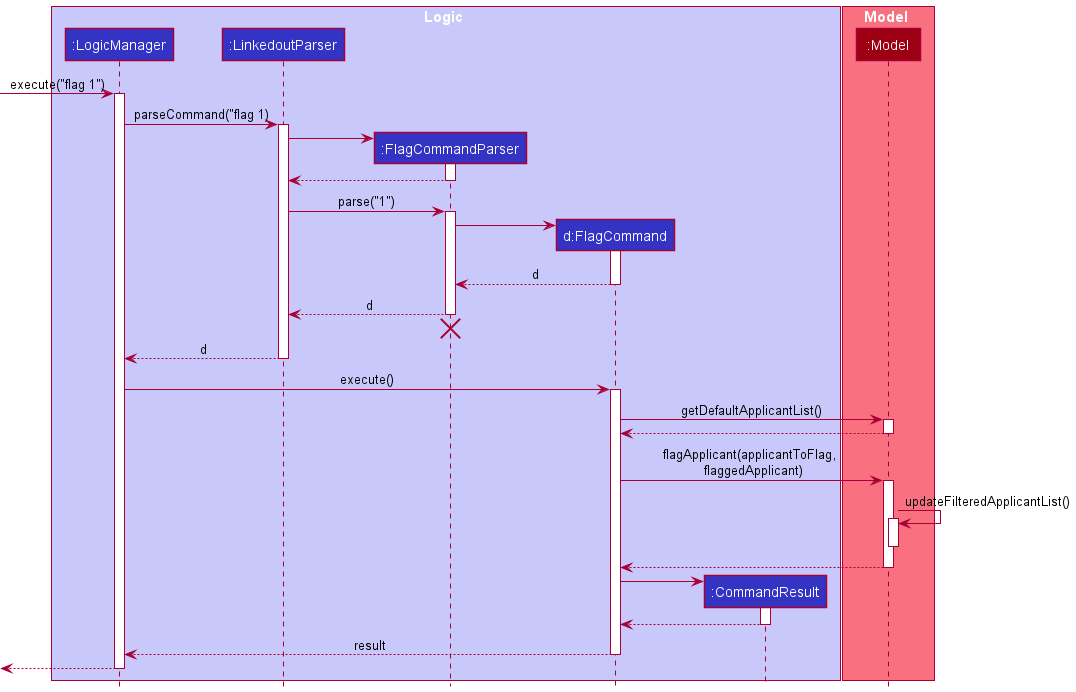
Design considerations
Aspect: How flag executes:
-
Alternative 1 (current choice): Create a new applicant with toggled flag status to replace the specified applicant.
- Pros: Immutability, easier to debug, and less side effects.
- Cons: More memory usage, more verbose to implement.
-
Alternative 2: Change the state of the applicant directly, by making the flag status mutable.
- Pros: Less verbose to implement.
- Cons: Change of applicant state makes debugging the application harder, and contains possibility of introducing side effects.
Documentation, logging, testing, configuration, dev-ops
Appendix: Requirements
Product scope
Target user profile:
- is a recruiter looking to hire for multiple jobs in a tech firm
- is reasonably comfortable using CLI apps
- Work pattern : works alone and does not share his/her computer
- Job scope : Many applications to sieve through on a daily basis
- Interaction level : Interacts with the applicants
Value proposition: Simple and easy-to-use tool for recruiter to LinkedOUT to applicants and manage the applicant’s information efficiently.
User stories
Priorities: High (must have) - * * *, Medium (nice to have) - * *, Low (unlikely to have) - *
| Priority | As a … | I want to … | So that I can… |
|---|---|---|---|
* * * |
Recruiter (new user) | add an applicant’s name, email, job applied, skills and application round | track and organize all the applicants for recruitment |
* * * |
Recruiter (new user) | view an individual applicant | see the details of a particular applicant |
* * * |
Recruiter (new user) | view the list of all applicants | have an overview of all applicants |
* * * |
Recruiter (new user) | delete an applicant | remove an applicant when he is rejected/withdraws application |
* * * |
Recruiter | edit applicant’s info | update their particulars |
* * * |
Recruiter that deals with large amounts of data | get rid of unwanted data | avoid getting confused by them. |
* * * |
Busy recruiter | search an applicant in the system by name. | have an overview of applicant’s particulars |
* * * |
Busy recruiter | search an applicant in the system by job, skill and round. | find the applicant with desired job, skill and round quickly |
* * * |
Familiar user and busy recruiter | to be able to search the applicants by job applied | view who is interviewing for the job and what rounds they are at. |
* * |
Recruiter that deals with large amounts of data | sort the applicant in the system by name | easily view by applicants in alphabetical order |
* * |
Recruiter that deals with large amounts of data | sort the applicant in the system by job applied | easily view by job applied in alphabetical order |
* * |
Busy recruiter | see what round of the job application a particular applicant is at | keep track of their progress |
* * |
Recruiter | add skills to existing skills that the applicant has | keep track of an applicant’s updated skill set |
* * |
Experienced recruiter | flag an applicant | quickly refer to their info in the future |
* * |
Recruiter (New user) | get alert from risky actions such as clearing the entire data | avoid clearing applicant’s data accidentally |
* * |
Recruiter | view a summary of any applicants skill set | not have to continuously reference their resume |
* * |
Recruiter(New user) | view a useful user guide | know how to use the application properly |
* * |
Recruiter(New user) | view on a summary of prefix and commands | easily know how to use the application properly |
* * |
Recruiter(New user) | get help from the application | know how to use the application |
* * |
Frequent user | avoid adding the same applicant | ensure the total number of applicants I entered is accurate |
* * |
Frequent user | avoid adding invalid email for the applicants | ensure the emails for applicants are valid |
* |
Efficient recruiter | import from files | avoid needing to key in everything manually |
* |
Efficient recruiter | work on the app smoothly | handle large amount of tasks at one time |
Use cases
(For all use cases below, the System is LinkedOUT, and the Actor is the user unless specified otherwise)
Use case 1: Add an applicant
Preconditions: LinkedOUT application is launched.
Guarantees: Applicant will be added only if the user input does not have any formatting issues.
MSS
- User requests to add a new applicant.
-
LinkedOUT shows the updated list of applicants.
Use case ends.
Extensions
-
1a. User provides an invalid input to add an applicant.
-
1a1. LinkedOUT shows an error message.
Use case resumes at step 1.
-
-
1b. User adds a duplicate applicant.
-
1b1. LinkedOUT does not add the applicant and shows an error message to the user.
Use case resumes at step 1.
-
Use case 2: View an individual applicant
Preconditions: LinkedOUT application is launched.
Guarantees: Applicant will be displayed only if the user input does not have any formatting issues.
MSS
- User requests to view an individual applicant.
-
LinkedOUT shows the individual applicant.
Use case ends.
Extensions
-
1a. Applicant does not exist.
-
1a1. LinkedOUT shows 0 applicants listed.
Use case resumes at step 1.
-
-
1b. User provides an invalid input to view applicant.
-
1b1. LinkedOUT shows an error message.
Use case resumes at step 1.
-
Use case 3: Search for applicant(s)
Preconditions: LinkedOUT application is launched.
Guarantees: Applicant(s) will be displayed only if the user input does not have any formatting issues.
MSS
- User requests to search for applicant(s) with a specific skill and job.
-
LinkedOUT shows the list of applicant(s) with the skill or job, in descending order of matched attribute.
Use case ends.
Extensions
-
1a. Applicant does not exist
-
1a1. LinkedOUT shows 0 applicant listed.
Use case resumes at step 1.
-
-
1b. User provides an invalid input to search for applicant(s).
-
1b1. LinkedOUT shows an error message
Use case resumes at step 1.
-
Use case 4: View list of all applicants
Preconditions: LinkedOUT application is launched.
Guarantees: List of applicants will be displayed.
MSS
- User requests to list applicants.
-
LinkedOUT shows a list of applicants.
Use case ends.
Extensions
-
2a. The list is empty.
Use case ends.
Use case 5: Delete an applicant
Preconditions: LinkedOUT application is launched.
Guarantees: Applicant will be deleted only if the user input does not have any formatting issues.
MSS
- User requests to list applicants.
- LinkedOUT shows a list of applicants.
- User requests to delete a specific applicant in the list.
-
LinkedOUT deletes the applicant.
Use case ends.
Extensions
-
2a. The list is empty.
Use case ends.
-
3a. The given index is invalid.
-
3a1. LinkedOUT shows an error message.
Use case resumes at step 2.
-
Use case 6: Edit an applicant
Preconditions: LinkedOUT application is launched.
Guarantees: Applicant will be edited only if the user input does not have any formatting issues.
MSS
- User requests to list applicants.
- LinkedOUT shows a list of applicants.
- User requests to edit a specific applicant in the list.
-
LinkedOUT edits the applicant.
Use case ends.
Extensions
-
2a. The list is empty.
Use case ends.
-
3a. The given index is invalid.
-
3a1. LinkedOUT shows an error message.
Use case resumes at step 2.
-
Use case 7: Sort the list of applicants
Preconditions: LinkedOUT application is launched
Guarantees: A temporarily sorted list of applicants will be displayed only if the user input does not have any formatting issues.
MSS
- User requests to list applicants.
- LinkedOUT shows a list of applicants.
- User requests to sort the list of applicants.
-
LinkedOUT shows the list of applicants in a sorted order.
Use case ends.
Extensions
-
2a. The list is empty.
Use case ends.
-
3a. User provides an invalid input to sort the list of applicants.
-
3a1. LinkedOUT shows an error message.
Use case resumes at step 3.
-
Use case 8: Add skills to an applicant
Preconditions: LinkedOUT application is launched. There is at least one applicant in the list.
Guarantees: Skills will be added to an applicant only if the user input does not have any formatting issues.
MSS
- User requests to list applicants.
- LinkedOUT shows a list of applicants.
- User enters the skill(s) to be added to the applicant.
- LinkedOUT shows the updated applicant.
Use case ends.
Extensions
-
2a. The list is empty.
Use case ends.
-
3a. User inputs invalid skill(s) or index.
-
3a1. LinkedOUT shows an error message
Use case resumes at step 3.
-
Use case 9: Flag an applicant
Preconditions: LinkedOUT application is launched. There is at least one applicant in the list.
Guarantees: Applicant will be flagged only if the user input does not have any formatting issues.
MSS
- User requests to flag an applicant
-
LinkedOUT shows the updated list of applicants
Use case ends.
Extensions
-
1a. User inputs invalid applicant index
-
1a1. LinkedOUT shows an error message
Use case resumes at step 1.
-
Use case 10: Unflag an applicant
Preconditions: LinkedOUT application is launched. There is at least one applicant in the list
Guarantees: Applicant will be unflagged only if the user input does not have any formatting issues.
MSS
- User requests to unflag an applicant
-
LinkedOUT shows the updated list of applicants
Use case ends.
Extensions
-
1a. User inputs invalid applicant index
-
1a1. LinkedOUT shows an error message
Use case resumes at step 1.
-
Use case 11: Clear all applicants
Preconditions: LinkedOUT application is launched.
Guarantees: List will be cleared only if the user input does not have any formatting issues.
MSS
- User requests to clear all applicants from the list
- LinkedOUT clears the list of all applicants.
Non-Functional Requirements
- Technical: The application should work on any mainstream OS as long as it has Java
11or above installed. - Performance: The application should be able to hold up to 1000 applicants without a noticeable sluggishness in performance for typical usage.
- Performance: The system should take at most 2 seconds to return an output.
- Disaster Recovery: In case of system failure, the application should still contain data saved up to the last command executed.
- Persistency: The system should save after executing commands that modify the list to ensure no data loss.
- Testing: There should be at least one test case for each major component.
- Fault Tolerance: The system should not crash due to an invalid input but instead show an error message.
- Portability: The application should run on an imported JSON file as long as it adheres to the format used when saving to files.
- Efficiency: A user with above average typing speed for regular English text (i.e. not code, not system admin commands) should be able to accomplish most of the tasks faster using commands than using the mouse.
- Usability: The user interface should be clean and intuitive for users who have basic IT knowledge.
- Process: The project is expected to adhere to a schedule based off our milestones from the different versions ranging from v1.1 to v1.4.
- Documentation: User Guide should be able to be understood by readers who have basic IT knowledge.
Glossary
- Mainstream OS: Windows, Linux, Unix, OS-X
- API: Application Programming Interface: Refers to a software acting as an intermediary allowing two applications to communicate with each other.
- JSON: JavaScript Object Notation: An open standard file format which we use to read and write data from.
- GUI: Graphical User Interface: Refers to the user interface that the user interacts with.
- CLI: Command Line Interface: Refers to a computer program that accepts text inputs.
Appendix: Instructions for manual testing
Given below are instructions to test the app manually.
Launch and shutdown
-
Initial launch.
-
Download the jar file and copy into an empty folder.
-
For Windows: Double-click the file to start the app.
For Mac: Open up a terminal in the current folder which contains the LinkedOUT jar file
Then, run the following command:java -jar LinkedOUT.jarExpected: Shows the GUI with a set of sample applicants. The window size may not be optimum.
-
-
Saving window preferences.
-
Resize the window to an optimum size. Move the window to a different location. Close the window.
-
Re-launch the app by double-clicking the jar file.
Expected: The most recent window size and location is retained.
-
Adding an applicant
![]() Code blocks for the Adding an applicant section:
The commands in code blocks for this section are meant to be inputted in one line.
Code blocks for the Adding an applicant section:
The commands in code blocks for this section are meant to be inputted in one line.
-
Adding an applicant while all applicants are being shown in the GUI.
-
Prerequisites: List all applicants using the
listcommand. Multiple applicants in the list. No other applicant named Alice in the list. Bob is an applicant in the list. - Test case:
add n/Alice p/99990000 e/alice@mail.com j/Software Engineer r/Technical Interview s/JavaExpected: An applicant named Alice with the above attributes will be added to the applicant list and displayed on the GUI.
- Test case:
add n/Bob p/99990000 e/bob@mail.com j/Site Reliability Engineer r/Technical Interview s/Jira s/SonarQubeExpected: No changes occur as an applicant named Bob is already in the list, and duplicate applicants with the same names are not allowed.
- Test case:
add n/Charles s/HaskellExpected: No changes occur as the phone number, email, job applied to and round of interview are all mandatory attributes that are not included in the above add command. These must be specified with the
p/,e/,j/andr/prefixes respectively.
-
Add skills to an applicant
-
Adding a skill to an applicant while all applicants are being shown in the GUI.
-
Prerequisites: List all applicants using the
listcommand. Multiple applicants in the list. Current State: The first applicant has pre-existing skills ofJavaScriptandTypeScript. -
Test case:
addskill 1 s/Python s/Java
Expected: New skillsPythonandJavaare added to the first applicant’s skill list. -
Test case:
addskill 1 s/JavaScript
Expected: No new skill will be added to first applicant’s skill list as it already exists. No error is thrown. -
Test case:
addskill 1 s/Javascript
Expected: New skillJavascriptwill be added to first applicant’s skill list. This is because the skills are case-insensitive, henceJavascriptandJavaScriptwill be treated as two different skills. -
Test case:
addskill 0 s/Python s/Java
Expected: No skill is added to any applicant. Error details shown in the status message. -
Other incorrect addskill commands to try:
addskill s/Python,addskill 1,addskill 1 Python,addskill x(where x is larger than the list size)
Expected: Similar to previous.
-
Editing an applicant
-
Editing an applicant while all applicants are being shown in the GUI.
- Prerequisites: List all applicants using the
listcommand. Multiple applicants in the list. Current State: The first applicant is Bob, with the following attributes:Name: Bob Phone Number: 99991111 Email Address: bob@mail.com Job Applied: Data Analyst Round: Interview Skills: Python -
Test case:
edit 1 n/Charles e/charles@mail.com
Expected: The first applicant’s name is changed toCharlesand the email address is changed tocharles@mail.com. All other attributes remain unchanged. -
Test case:
edit 1 s/Javascript s/Java
Expected: The first applicant’s existing skills are removed, and onlyJavascriptandJavawill be in their skill list. All other attributes remain unchanged. -
Test case:
edit 1 s/
Expected: All skills are removed from the first applicant, their skill list will now be empty. All other attributes remain unchanged. -
Test case:
edit 0 n/Jamie
Expected: No changes occur, as 0 is an invalid index. Error details shown in status message - Other incorrect edit commands to try:
edit o/Jamie,edit p/Jamie,edit x n/Jamie(where x is greater than list size).
Expected: Similar to previous.
- Prerequisites: List all applicants using the
View an applicant
-
View an applicant while all applicants are being shown in the GUI.
-
Current State: The list has pre-existing applicants. The first applicant has full name of
Bob Tan. -
Test case:
view Bob Tan
Expected: Only applicant namedBob Tanis displayed in the list. -
Test case:
view Tan
Expected: No applicant is displayed in the list. -
Test case:
view n/Bob Tan
Expected: No applicant is displayed in the list. This is because prefix is not needed in view. -
Test case:
view BobTan
Expected: No applicant is displayed in the list. This is because exact full name with correct spacing is needed to view on an applicant. -
Test case:
view bob tan
Expected: Only applicant namedBob Tanis displayed in the list. This is because full name are case-insensitive. -
Other incorrect view commands to try:
viewandView
Expected: No applicant is displayed. Error details shown in the status message.
-
Searching for applicant(s)
-
Searching for applicant(s) while all applicants are being shown in the GUI.
-
Current State: The list has pre-existing applicants. The first applicant has name of
Bob Tanwith job inSoftware Engineer. The second applicant has name ofAmy Tanwith job inSoftware Developer. -
Test case:
search n/Tan
Expected: Both applicants are displayed in the list. -
Test case:
search n/Bob
Expected: Only applicant namedBob Tanis displayed in the list. -
Test case:
search n/bOb
Expected: Only applicant namedBob Tanis displayed in the list. This is because search attributes are case-insensitive. -
Test case:
search n/Jason
Expected: No applicant is displayed in the list. -
Test case:
search n/Bo
Expected: No applicant is displayed in the list. This is because search attribute has to be an exact word (can be split by spacing). -
Test case:
search j/Bob
Expected: No applicant is displayed in the list. This is because the search attribute has to match with the correct prefix. -
Test case:
search n/Tan j/Engineer
Expected: Both applicants are displayed in the list butBob Tanis shown on the top of the list. This is because applicant with the most matching attributes will be displayed first. -
Test case:
search n/Amy j/Engineer
Expected: Both applicants are displayed in the list and the order of applicant shown is based on the original list. In this case,Bob Tanis shown aboveAmy Tan. -
Other incorrect search commands to try:
search,Search,search Bob,search w/Bob,search n/
Expected: No applicant is displayed. Error details shown in the status message.
-
Sorting list of applicants
-
Sorting the list of applicants temporarily while all applicants are being shown.
-
Prerequisites: List all applicants using the
listcommand. Multiple applicants in the list. If list is empty, sorting will have no result but sorting is still available. -
Test case:
sort f/name o/asc
Expected: A temporary sorted list of applicants will show with applicants sorted in ascending alphabetical order with their names. -
Test case:
sort f/name o/desc
Expected: A temporary sorted list of applicants will show with applicants sorted in descending alphabetical order with their names. -
Test case:
sort f/job o/asc
Expected: A temporary sorted list of applicants will show with applicants sorted in ascending alphabetical order with the job they applied to. -
Test case:
sort f/email o/asc
Expected: A temporary sorted list will not be shown. Error details shown in the status message. -
Other incorrect delete commands to try:
sort f/skill o/asc,sort f/job o/ascending,sort name asc
Expected: Similar to previous.
-
Flagging an applicant
-
Flagging an applicant while all applicants are being shown in the GUI.
-
Prerequisites: List all applicants using the
listcommand. Multiple applicants in the list. Current state: The first applicant is presumed to be unflagged. -
Test case:
flag 1
Expected: First applicant is flagged, a flag icon appears to the right of applicant details and flagged applicant is now at the top of the list. -
Test case:
flag 1
Assumption: Test case above is completed, and the first applicant is now flagged.
Expected: First applicant is now unflagged, flag icon disappears, and applicant is no longer at the top of the list. -
Test case:
flag -1
Expected: No applicant is flagged as index is invalid. Error details shown in the status message. -
Test case:
flag 999999999999
Expected: No applicant is flagged as index is too large to be parsed. Error details shown in the status message. -
Other incorrect flag commands to try:
flag,flag 1 1,flag x, (where x is larger than the list size)
Expected: Similar to test case 4.
-
Deleting an applicant
-
Deleting an applicant while all applicants are being shown in the GUI.
-
Prerequisites: List all applicants using the
listcommand. Multiple applicants in the list. -
Test case:
delete 1
Expected: First applicant is deleted from the list. Details of the deleted applicant shown in the status message. -
Test case:
delete 0
Expected: No applicant is deleted. Error details shown in the status message. -
Other incorrect delete commands to try:
delete,delete 1 1,delete x, (where x is larger than the list size)
Expected: Similar to previous.
-
Clearing the application
-
Clearing all applicants from LinkedOUT when multiple applicants are being shown in the GUI.
-
Test case:
clearfollowed by clickingYeson the confirmation box.
Expected: All applicants are deleted from the application, an empty list is seen. -
Test case:
clearfollowed by clickingNoon the confirmation box.
Expected: No changes occur in the application, list of applicants remain unchanged. -
Test case:
clearfollowed by closing the confirmation box.
Expected: No changes occur in the application, list of applicants remain unchanged. -
Test case:
clear x(where x can be a Integer or a String).
Expected: Confirmation box pops up, outcomes similar to test cases i, ii and iii.
-
Saving data
- Saving data
- Prerequisites: Permanently modify list of applicants using any commands.
- Test case:
delete 1follow byexitcommand and relaunch the app.
Expected: First applicant beforedeletecommand will not be in the list of applicants upon relaunch.
- Dealing with missing files
- Prerequisites: JSON file is missing, delete
data/linkedout.jsonfile to simulate the missing file. - Launch the app.
Expected: The app starts with a default list of applicants.
- Prerequisites: JSON file is missing, delete
- Dealing with corrupted data files
- Prerequisites: JSON file is corrupted, modify
data/linkedout.jsonfile with any software that can edit the file and save. - Launch the app.
Expected: The app starts with an empty list of applicants.
- Prerequisites: JSON file is corrupted, modify